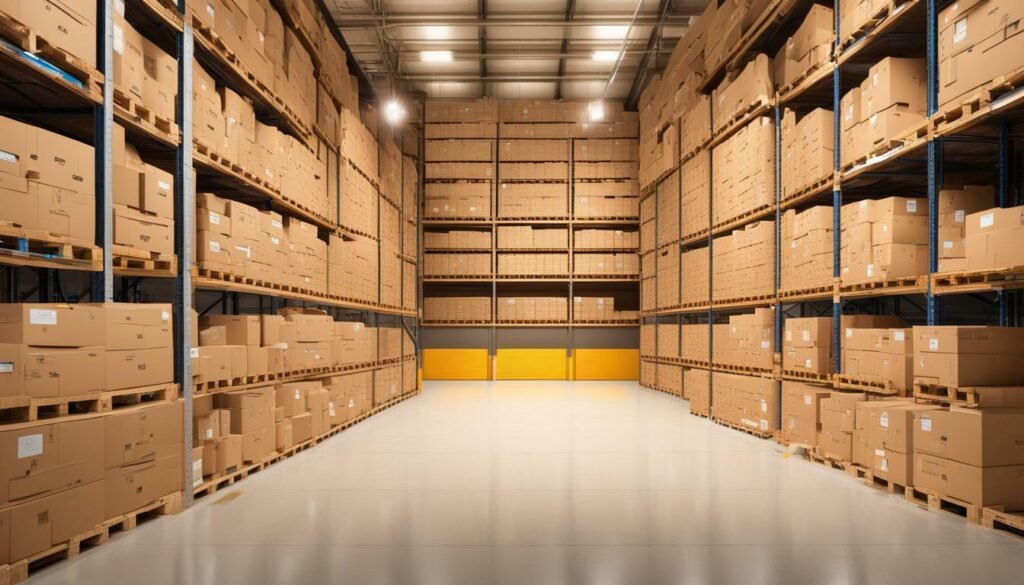
A self-storage business is a lucrative venture that is fast gaining popularity in the United States. However, like any other business, success in the self-storage industry requires proper planning and execution. This is where a self-storage business plan comes into play. A comprehensive business plan acts as a roadmap that outlines the steps to be taken in order to achieve the desired results.
Whether you are a first-time entrepreneur or an experienced business person, a self-storage startup guide can help you navigate the intricacies of this industry. From market analysis to financial projections, a startup guide provides a step-by-step process to guide you towards success.
One of the key elements of a self-storage business plan is the business model. This is essentially a framework that outlines how the business will generate revenue. A proper business model can help ensure long-term success and profitability for your self-storage business. In this section, we will provide a comprehensive guide to developing a successful self-storage business plan.
Contents
- 1 Self-storage Market Analysis
- 2 Self-Storage Facility Plan
- 3 Self-storage Financial Projections
- 4 Self-storage Business Model
- 5 Warp Up
- 6 FAQ
- 6.1 Q: What is the importance of a self-storage business plan?
- 6.2 Q: What should be included in a self-storage startup guide?
- 6.3 Q: What factors contribute to success in the self-storage business?
- 6.4 Q: How can I plan and develop a self-storage facility?
- 6.5 Q: What should I consider when creating financial projections for my self-storage business?
- 6.6 Q: What are the different revenue streams in the self-storage business?
Self-storage Market Analysis
Before starting a self-storage business, it’s essential to conduct a thorough market analysis. Understanding the current trends and dynamics of the industry can help you develop a winning business strategy and gain a competitive edge.
The self-storage market has been growing steadily in the United States, with an average annual growth rate of 3.7% over the past five years. With an increasing number of people downsizing their homes or moving for work, the demand for self-storage units has never been higher.
When conducting a market analysis, it’s crucial to consider various factors, including the location, size, and type of facility you plan to establish. Additionally, researching the competition in the area and analyzing their strengths and weaknesses can provide valuable insights into how to differentiate your business.
Self-storage Business Strategy
Developing a solid business strategy is key to succeeding in the self-storage industry. One effective approach is to target niche markets, such as providing specialized storage for RVs, boats, or vintage cars. Offering additional services, such as moving supplies or truck rental, can also attract more customers and generate additional revenue streams.
Another essential aspect of a successful self-storage business strategy is to prioritize customer service. Investing in a well-trained staff and providing convenient access to the facility can help build strong relationships with customers and generate positive word-of-mouth marketing.
Self-storage Business Tips
Here are some additional tips to keep in mind when establishing a self-storage business:
- Choose a location with high visibility and accessibility.
- Invest in security measures, such as video surveillance and controlled access.
- Consider offering climate-controlled units to attract customers with valuables that require special storage conditions.
- Develop a digital marketing strategy to reach potential customers online.
By conducting a thorough market analysis, developing a winning business strategy, and implementing effective tips and best practices, you can establish a profitable self-storage business in the booming U.S. storage industry.
Self-Storage Facility Plan
A crucial component of a self-storage business plan is the development of a comprehensive facility plan. As an aspiring self-storage entrepreneur, you need to consider several factors before constructing your facility.
First, choose a suitable location for your self-storage facility. Consider factors such as proximity to residential areas, accessibility, and ease of navigation.
| Location | Pros | Cons |
|---|---|---|
| Urban | Higher population density, increased visibility. | Higher rent, more competition. |
| Rural | Lower rent, less competition. | Lower population density, reduced visibility. |
Second, determine the size and layout of your facility. Assess the demand for self-storage in the area and ensure that your facility will meet the needs of potential customers. Consider the number of units, unit sizes, and accessibility options.
Third, prioritize security measures to protect your customers’ belongings. Consider implementing surveillance cameras, gated access, and alarm systems.
Lastly, create an investment plan to finance the construction and operation of your self-storage facility. Consider the cost of land, construction materials, labor, and equipment. Determine the necessary funding and potential return on investment.
By developing a comprehensive self-storage facility plan, you can ensure that your business will meet the demand of potential customers in a suitable location while prioritizing effective security measures and financial planning for a successful business venture.
Self-storage Financial Projections
Creating accurate financial projections is crucial for any successful self-storage business. It allows you to make informed decisions about the future growth of your business and also attracts potential investors. Here are some key factors to consider when projecting finances:
| Revenue Streams | Percentage of Total Income |
|---|---|
| Rental Fees | 70% |
| Ancillary Services (e.g. moving supplies) | 15% |
| Retail Sales (e.g. locks) | 15% |
Operating expenses will vary depending on the size and location of your facility, but some common expenses include staff salaries, maintenance costs, and marketing expenses. It’s important to research and accurately estimate these expenses in your financial projections.
- Staff Salaries: 40%
- Maintenance Costs: 20%
- Marketing Expenses: 10%
- Insurance: 5%
- Utilities: 5%
- Other Expenses: 20%
Growth projections should be realistic and based on market trends and demand. Research and consider the competition in the area, as well as any potential changes in the market that could affect your business. It’s also important to have a contingency plan in case of unexpected changes or challenges.
Overall, accurate financial projections are crucial for the success of your self-storage business. By considering all relevant factors and creating realistic projections, you can make informed decisions and attract potential investors.
Self-storage Business Model
A successful self-storage business model requires a clear understanding of revenue streams, operational strategies, and investment plans.
The primary source of revenue in the self-storage industry is rental fees. Operators charge customers based on the size and location of the storage unit, with prices varying depending on market demand. Ancillary services, such as truck rentals and packing supplies, can also generate additional revenue streams. Retail sales, such as selling boxes and moving supplies, can also boost profits.
Operational strategies are essential for running a profitable self-storage business. Operators should focus on maintaining a high occupancy rate, reducing delinquencies, and minimizing operating expenses. Providing excellent customer service, maintaining clean and secure facilities, and implementing effective marketing campaigns can help attract and retain customers.
In terms of investment plans, self-storage operators should aim to minimize upfront costs and maximize revenue potential. Developing a detailed financial plan can help operators allocate funds efficiently, manage cash flow, and attract potential investors. It is crucial to consider the cost of land, construction, and equipment when developing an investment plan, as well as ongoing operating expenses such as utilities, property taxes, and insurance.
Overall, a strong business model is critical for success in the self-storage industry. By focusing on revenue streams, operational strategies, and investment plans, operators can position themselves for growth and profitability.
Warp Up
In conclusion, the self-storage industry in the United States is experiencing demand like never before. As a result, entrepreneurs looking for a profitable business venture should consider investing in self-storage.
However, success in the industry requires more than just a good location and a few units. A well-structured and comprehensive business plan is essential for navigating the competitive landscape and positioning yourself for growth. By analyzing the market, developing a facility plan, creating accurate financial projections, and implementing a solid business model, you can set yourself up for success in this lucrative industry.
Remember, the most successful self-storage entrepreneurs understand that a successful business is built on customer service, quality facilities, and smart business practices. Stay focused on these elements, and you are sure to find success in the self-storage industry.
FAQ
Q: What is the importance of a self-storage business plan?
A: A self-storage business plan is essential as it serves as a roadmap for your entrepreneurial journey. It outlines your goals, strategies, and financial projections, helping you make informed decisions and attract potential investors.
Q: What should be included in a self-storage startup guide?
A: A self-storage startup guide should include detailed information about the market analysis, facility planning, financial projections, and operational strategies. It serves as a comprehensive resource for aspiring self-storage entrepreneurs.
Q: What factors contribute to success in the self-storage business?
A: Success in the self-storage business is influenced by factors such as market demand, strategic location, competitive pricing, exceptional customer service, and effective marketing strategies.
Q: How can I plan and develop a self-storage facility?
A: Planning and developing a self-storage facility involves considerations such as selecting the right location, determining the optimal size and layout, implementing state-of-the-art security measures, and understanding the financial aspects and investment plans.
Q: What should I consider when creating financial projections for my self-storage business?
A: When creating financial projections for your self-storage business, it is important to consider factors such as revenue streams (rental fees, ancillary services, retail sales), operating expenses, growth projections, and potential risks and challenges.
Q: What are the different revenue streams in the self-storage business?
A: The self-storage business offers various revenue streams, including rental fees for storage units, income from ancillary services (such as truck rental or packing supplies), and potential retail sales of storage-related products.
- Can you become a millionaire by investing in real estate? - November 7, 2023
- What form of AI is most commonly used in real estate? - November 5, 2023
- What is the AI real estate market forecast? - November 3, 2023
